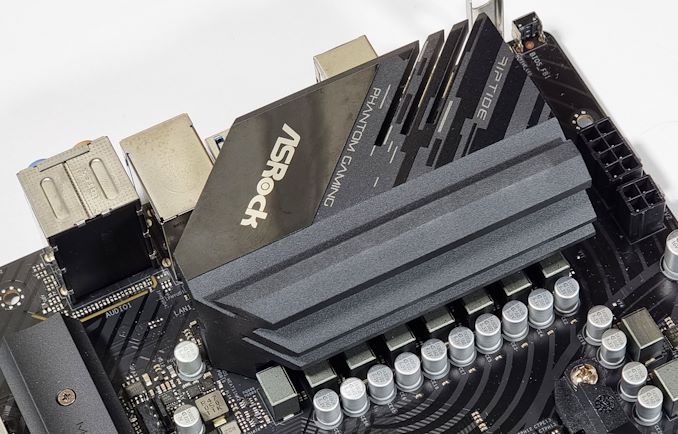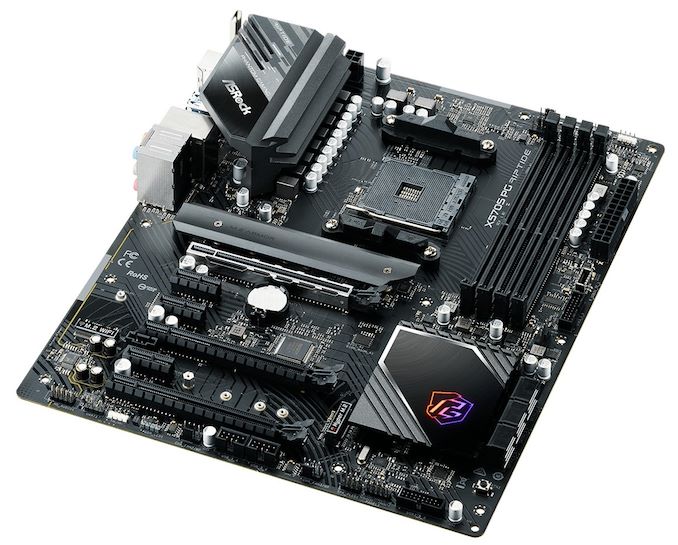The ASRock X570S PG Riptide Motherboard Review: A Wave of PCIe 4.0 Support on A Budget
by Gavin Bonshor on October 22, 2021 9:00 AM EST
Officially announced at Computex 2021, AMD and its vendors unveiled a new series of AM4 based motherboards for Ryzen 5000 processors. The new X570S chipset is, really, not that different from the previous version launched back in 2019 from a technical standpoint. The main user difference is that all of the X570S models now feature a passively cooled chipset. Some vendors have opted to either refresh existing models, or others are releasing completely new variants, such as the ASRock X570S PG Riptide we are reviewing today. Aimed at the entry-level extreme chipset, the X570S PG Riptide features a Killer-based 2.5 GbE controller, dual PCIe 4.0 x4 M.2 slots, and support for up to 128 GB of DDR4-5000.
ASRock X570S PG Riptide: The Tide is High
At the launch of the original X570 chipset back in 2019, many users stressed that they were worried that the actively cooled chipset heatsinks were going to generate extra noise, or by using smaller fans they would fail early. In reality, the chipset fans didn't generate THAT much noise, but for some users, they still expressed their annoyance. Fast forward to 2021, and at Computex 2021, the latest X570S chipset models now feature passively cooled chipset heatsinks. Another avenue that the X570S chipset brings to the table is that motherboard vendors have been able to refresh some of its previous X570 models and added more up-to-date controller sets, extending their offerings with the latest and greatest.
The ASRock X570S PG Riptide represents a new entry in ASRock's gaming-themed Phantom Gaming series, but at the more entry to a mid-level market segment, which for an X570 board might be most people's mid-range or even high-end for cost. Designed primarily for AMD's latest Ryzen 5000 processors, it is also compatible with both the Ryzen 3000 and 2000 series of desktop processors, but it also supports Ryzen 5000, 4000, and 3000 APUs. It also has four memory slots with support for fast DDR4-5000 memory, with a maximum combined capacity of up to 128 GB.
ASRock adopts a more simplistic aesthetic for its X570S PG Riptide, with a mixture of grey, black, and silver throughout. ASRock is advertising a 10-phase power delivery cooled by a single heatsink that doubles up as a rear panel cover. The passively cooled X570S chipset keeps things quieter than the previous generation, with a smidgen of integrated RGB LED lighting. If that's not enough for some users, ASRock includes two addressable RGB and two regular RGB headers to add additional RGB LED strips to jazz up their systems.
The ASRock X570S PG Riptide offers a more affordable route to the full levels of PCIe 4.0 support that both Ryzen 5000 and X570 combined offer uses. For PCIe slot support, ASRock includes one full-length PCIe 4.0 x16 slot, one full-length PCIe 4.0 x4 slot, one full-length PCIe 4.0 x2, and three PCIe 4.0 x4 slots. ASRock also includes PCIe 4.0 storage support via two PCIe 4.0 x4 M.2 slots, with six SATA ports compatible with AMD RAID 0, 1, and 10 arrays. Other notable features include one of the latest Killer-based 2.5 GbE controllers, with USB 3.2 G2 Type-A and Type-C connectivity on the rear panel, as well as a mid-range HD audio codec driving the board's audio. For users looking to add wireless capabilities, the ASRock X570S PG Riptide does have an additional M.2 Key-E for users to add their own M.2 2230 Wi-Fi and BT modules.
Touching on performance, the ASRock X570S PG Riptide performed competitively against other AM4 boards we've tested, with a decent showing in our system tests such as POST time testing and power consumption. In our DPC latency testing, it wasn't anything special, and performance in our compute and gaming tests put it exactly where we would expect it to be, in competition with the rest of the field.

The ASRock X570S PG Riptide undergoing our VRM thermal testing
Regarding overclocking, the ASRock also performed creditably given it's at the lower end of X570/X570S models currently available in terms of price. We managed to overclock our testbed AMD Ryzen 7 3700X to 4.3 GHz all-core stable, which is standard for most AM4 boards we've tested. Still, the board exceeded our expectations regarding tight VDroop control at load compared to the values we set for the CPU VCore in the firmware. The board's VRM thermal performance was also acceptable, even if it ran warmer than the more premium models we've tested.
Looking at pricing, the ASRock X570S PG Riptide has an MSRP of $185, which if you compare it to other X570 models in its arsenal, such as the ASRock X570 Steel Legend ($200), the PG Riptide has a much more up-to-date and premium Ethernet controller, as well as better memory support out of the box. Believe it or not, there's not much in the way of available X570S boards at both Amazon, Newegg, or Microcenter to actually compare the PG Riptide to.
One equally competitive model in the realm of X570S is the MSI MAG X570S Torpedo Max, which costs around $200 and uses 2.5 GbE, a secondary Gigabit LAN port as well as a much more recent HD audio codec. Whether a user's motherboard selection is dependent on features, price, aesthetic, or a combination of all three, the ASRock X570S PG Riptide looks interesting in the sub $200 market. The biggest question, however, from our point of view, is how does it stack up against other AM4 models we've tested so far. It's time to take a closer look and see what if the ASRock X570 PG Riptide can hold its own in shark-infested waters.
Read on for our extended analysis.











39 Comments
View All Comments
Arbie - Friday, October 22, 2021 - link
$185 - which you could spend on a set of aluminum lawn chairs. I am continually astounded that an ultra-high tech assembly like this, with hundreds of parts each microscopically created, comprising millions of transistors, and with multiple PCB layers, countless holes precisely drilled, and the whole thing electrically and electronically designed, all the drawings, BOM, logistics, testing etc, can appear on a shelf here at this price. Or at twice the price. Or three times.Just an observation...
meacupla - Friday, October 22, 2021 - link
That's because your aluminum lawn chairs are overpriced, and have significantly better margins. They probably only cost around $20 to make, $30 to ship, and $30 to store in a your local warehouse, until you bought them. That leaves more than a 50% profit margin for the manufacturer.Where as Mobos have significantly less margin. Mobo makers only have around 10% profit per sale of a mobo, and less than 8% on graphics cards, by the time you can buy one locally. This is also the reason why it's so hard to get RMAs on mobos and graphics cards for certain manufacturers.
Arbie - Friday, October 22, 2021 - link
So if lawn chairs cost half as much, mobos would be 0.5 x 10^6 more complex per dollar, instead of 1.0 x 10^6. I get it.TheITS - Friday, October 22, 2021 - link
It's much more logically explained by economies of scale, not complexity.Arbie - Friday, October 22, 2021 - link
I doubt that orders of magnitude more "ASRock X570S PG Riptide" mobos will be sold than say "Walmart Model XYZ" lawnchair sets. There are major economies of scale in the electronic subcomponents, but the lawnchairs have some too.Overall, I can far more easily see how lawnchairs might arrive at such a price than how a mobo can. In fact the latter appears miraculous compared to almost anything within 10x its price.
Wrs - Saturday, October 23, 2021 - link
Bulk is a primary cost factor for lawn chairs made abroad. It limits how many products you can pack per container for shipment. For a typical product originating from SE Asia, remember each container has to make the sea and land journey round trip. That typically ranges from $25000-40000 for a 40' truckload to the US, or $600-1000 per linear foot. This holiday season there are unusual shipping backlogs and the price has spiked to $2000 or something. Might not be the best year to get lawn chairs. A corollary is that the more compact the chairs fold or stack into, the cheaper they can be sold for.A mobo box being around 2 large books is comparatively easy to pack, but more importantly the tiny size of most of the components makes shipping costs to assembly site almost trivial. With Moore's law shrinking chips so much, one can still pack millions of transistors on a mature node for just pennies.
ballsystemlord - Friday, October 22, 2021 - link
Technical correction @Gavin . You didn't mean to write "... and three PCIe 4.0 x4 slots." You intended "... and three PCIe 4.0 x1 slots".geniekid - Friday, October 22, 2021 - link
How well does the GPU bracket/holder actually work?Tomatotech - Friday, October 22, 2021 - link
You know, I’m reading this mobo review after reading the details of the new M1 Pro / Max SoC, and all I can think of is that this mobo looks so large and outdated.I think it’s time for processors to start being soldered on, for Intel at least, as they change their sockets so often. I’d happily buy a CPU + mobo + decent igpu + ram + a TB or 2 of SSD space onboard. The whole package should cost less than buying the parts separately and work far better.
The cheaper CPUs can come with 8GB soldered on and the better ones with 16/32/64GB RAM options. 1 TB onboard of fast soldered SSD is enough for most people, and there can still be a M2 slot for adding a few more TB.
I’m not sure how to keep the ability to add a beefy GPU, maybe have a single high speed slot, plus the ability to add a daughterboard with a few more slots if needed, connected by a TB4 cable. (TB is basically PCIe over a cable).
Won’t be to everyone’s taste but it would make life easier and cheaper. Technology marches on and HDDs no longer have replaceable platters (drums), or replaceable arms / actuators. Time to take the next step and integrate the CPU and RAM, god knows Intel’s CPUs need a better RAM connection.
isthisavailable - Saturday, October 23, 2021 - link
How about no?